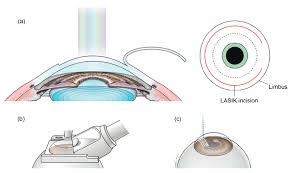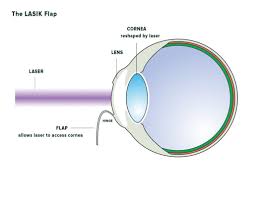Table of Contents
ToggleResidual power after LASIK refers to the slight refractive error that may remain in the eyes post-surgery, usually minor and often not needing correction.
While LASIK surgery is highly effective at improving vision, it does not always guarantee perfect 20/20 vision due to individual variations and healing responses.
For many contemplating LASIK or those who have already undergone the procedure, understanding residual power is crucial. This blog will provide a comprehensive breakdown of what residual power is, what might cause it, and what options are available to address it.
What Does Residual Power Mean?
Residual power, sometimes referred to as residual refractive error, is the term used for the small degree of vision correction that may still be necessary after LASIK. This could manifest as mild short-sightedness (myopia), far-sightedness (hyperopia), or astigmatism.
Though LASIK reshapes the cornea for precise vision correction, it cannot account for every slight anomaly, especially in those with higher pre-surgical prescriptions. For many, the residual power is so minor that it does not impact daily life or even require corrective measures. For others, it might necessitate glasses for tasks such as night driving or reading fine print.
Can Perfect Vision Be Guaranteed After LASIK?
While LASIK boasts a remarkable success rate, attaining perfect vision cannot always be guaranteed. Studies suggest that over 95% of LASIK patients achieve 20/40 vision or better, while 85% reach the coveted 20/20 vision mark. However, individual healing patterns and pre-surgical conditions may influence outcomes.
Factors Affecting Residual Power
Several factors can play a role in whether or not residual power occurs after LASIK. Here are some of the most common:
1. Pre-Surgery Prescription
Individuals with higher prescriptions (severe myopia, hyperopia, or astigmatism) may find it challenging to achieve zero refractive error. The complexity of correcting strong prescriptions introduces a higher likelihood of minor residual power.
2. Healing Response
The eye’s healing process is unique to each individual. Some patients experience slight corneal regression as the eye heals, which can lead to residual refractive errors over time.
3. Technological Limitations
Though LASIK technology is highly advanced, the precision of vision correction has its limits. Minor discrepancies during the reshaping of the cornea or slight imperfections in the laser settings may result in residual errors.
4. Age-Related Factors
Patients in their late 30s or older may develop age-related vision changes, such as presbyopia, which LASIK does not correct. This can sometimes be mistaken for residual power.
5. Underlying Eye Conditions
Unpredictable factors such as dry eyes, corneal irregularities, or even undiagnosed conditions may affect recovery and the overall accuracy of the correction.
6. Surgical Technique or Pre-Existing Issues
Residual power may also stem from a less-than-optimal initial correction. For example, if not enough corneal tissue is removed or if irregularities in the healing process arise.
Common Visual Symptoms of Residual Power
If residual power does occur post-LASIK, patients may experience some of the following visual symptoms:
- Slight blurriness or haziness in vision
- The need for glasses or lenses in specific situations (night driving, reading)
- Light halos or glare (common during nighttime)
- Mild eye strain during extended periods of focus
While these symptoms may sound concerning, it’s essential to note that they are usually mild and do not affect the surgical success rate significantly.
How is Residual Power Diagnosed?
Monitoring your vision after LASIK surgery is critical. Residual power is typically diagnosed during post-operative checkups through:
- Vision tests: Routine eye exams can detect slight refractive errors.
- Wavefront technology scans: Advanced diagnostic tools analyse how light travels through the eye, revealing any remaining refractive irregularities.
Your surgeon will usually assess whether your vision can adjust to the residual power naturally or if corrective intervention is necessary.
Management & Corrective Solutions for Residual Power
For most patients, residual power isn’t an issue that requires significant attention. However, for those noticing occasional inconvenience, several options are available:
1. Laser Retreatment
LASIK enhancement, or laser retreatment, is an effective solution to address residual power. This involves refining the cornea’s shape further to achieve near-perfect correction. Retreatment is generally only recommended for stable patients who meet certain criteria, including sufficient corneal thickness.
2. Glasses or Contact Lenses
Though rare, some people may opt for glasses or contact lenses for tasks requiring extra precision, such as driving at night or long reading sessions. These solutions are temporary and situational.
3. Custom Wavefront LASIK
For those with irregular or complex residual refractive errors, wavefront-guided LASIK—a more precise and tailored variation of traditional LASIK—may address the issue.
4. Orthokeratology Lenses (Ortho-K)
For minor residual errors, specialised overnight contact lenses may temporarily reshape the cornea, allowing clear vision during the day.
5. Waiting for Stability
Post-LASIK healing takes time, and regressing vision often stabilises on its own within three to six months. Many eye surgeons recommend monitoring vision changes during this period before making decisions about additional treatments.
Preventing Residual Power Post-Surgery
While it may not always be possible to avoid residual power entirely, specific pre-surgery steps and precautions can enhance outcomes:
- Thorough Pre-Operative Assessment
Opting for a comprehensive eye scan and refractive analysis is critical. Discuss your specific prescription and expectations openly with your surgeon to set realistic goals.
- Choose Advanced Technology
LASIK devices like femtosecond lasers or wavefront-guided systems tend to offer higher precision, especially for unique corneas or higher prescriptions.
- Follow Post-Surgery Care Guidelines
Adhering to your surgeon’s aftercare instructions ensures that your corneas heal optimally, reducing the chance of regression.
- Select an Experienced Surgeon
The expertise of your LASIK provider plays a pivotal role in your long-term vision quality. Be thorough in researching their qualifications and success rates.
Final Thoughts on Residual Power After LASIK
LASIK is a revolutionary procedure that significantly enhances vision quality and eliminates the dependence on glasses or contact lenses for most people. However, it’s important to understand that minor residual power is a possibility, albeit a manageable one.
The key lies in being an informed and proactive patient—pre-surgery preparation, following post-surgery care routines, and committing to regular checkups are essential for achieving the best results.
If you experience any concerns or notice vision issues following your LASIK procedure, consult your surgeon immediately. Residual power can often be addressed with minimal fuss, leading you back to clear, sharp vision.
With the right approach, LASIK can indeed be life-changing, giving you the freedom and confidence to see the world in a whole new light!













